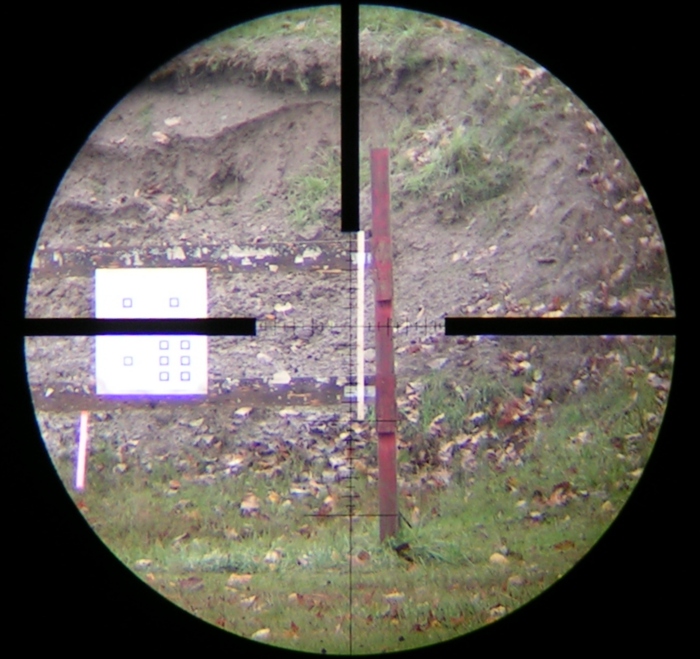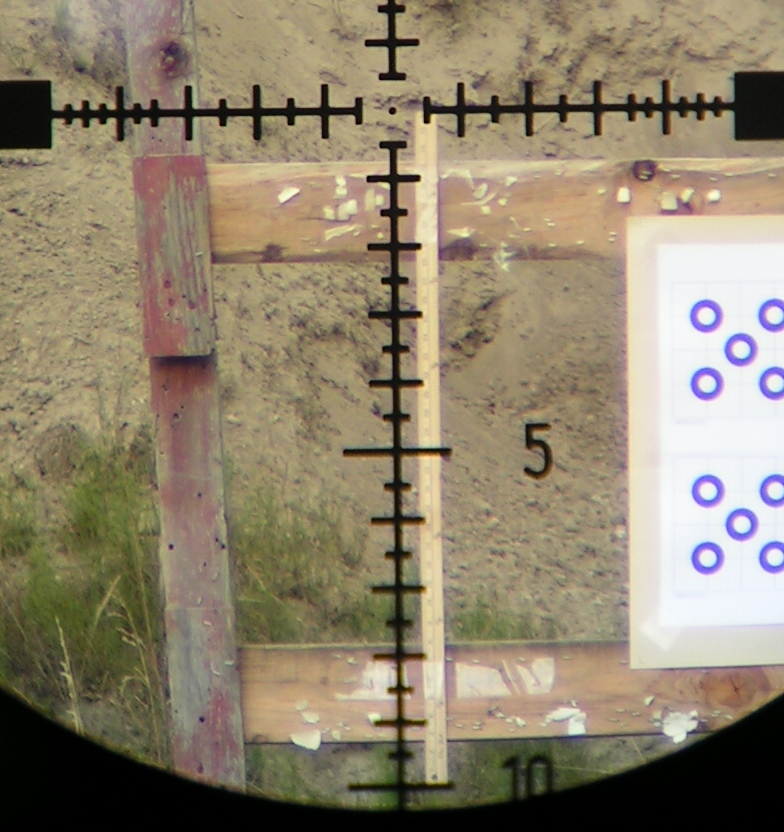Re: Vortex Viper PST 4-16X50 FFP Initial Impressions
Good words, Jeff. And good tips on measuring scopes. Thanks.
For others asking, I'll try and give a little primer.
First of all, check out Lindy's
http://www.arcanamavens.com/LBSFiles/Shooting/Downloads/ScopeChecking/ for some excellent information some of which I'll duplicate below.
It's not rocket science guys, you don't need to be an Engineer or even be particularly smart. You just need to be smart enough to realize it's an important thing to do if you shoot long range much.
About the easiest method in "the real world" is with a yardstick because everybody has one and they work out nicely being exactly 10 Mils at 100 yds:
Naturally it's easier to be more accurate with a higher powered scope:
Easy way to verify the calibration of your reticle. 10 mils, 36". Bam, done.
Next you want to verify click value and/or reticle perpendicularity with respect to the turret movement. For this you need to hold the rifle very steady. It's very difficult to do by yourself by hand; if you do it a bunch of times and sort of take an average you can get an idea if there's a big error but you won't be exact. Having buddies hold the rifle and click the scope while you look increases accuracy somewhat. But by far the best is having a gunsmith vice of some type so you can solidly lock down the rifle.
I've seen people mention using calibrated paper. That's fine too as long as it's big enough (measuring 10" or so at 100 yds just isn't enough accuracy; I feel 10 mils or more is the minimum), it's far enough (the closer the paper or object is the smaller the errors will be that you're trying to measure) and it needs to be far enough you can eliminate parallax <span style="font-weight: bold">completely.</span>
You don't even need any measuring device to get some good data. With a good tactical reticle, you can get a relative measurement between the reticle and the turrets by pointing at anything. Typical Mil reticles are very easy as the top and bottom posts are usually 10 Mils apart. Simply line the top of the bottom post on an aiming point in the distance exactly and crank in 10 mils. If the top post's edge is now exactly where the bottom post's edge was, your reticle matches your clicks.
Relatively speaking they're dead on with one another. You should still check them with a yardstick, barber pole, etc, to make sure they're absolutely correct, but in my experience reticles are more consistent than click values so your odds look good.
The same goes for reticle cant with respect to the turrets. All you need is a straight edge at which to aim. It can be a yardstick, post, corner of a building, etc. But it needs to be perfectly straight.
Lock down the rifle with the reticle on the edge--exactly lined up on the edge and crank in 10 mils or so. If the reticle stays on the edge, you're good. If it moves laterally with your vertical turret input, you have a reticle that's not square with the turrets. Clicking windage to see how many clicks it takes to put the reticle back on the edge will allow you to calculate the angle.
Another tool one can use to check these things is a collimator. Some quality boresighters with a good grid qualify so we aren't talking about some super expensive lab equipment here. If you do things correctly, you will get exactly the same answers using one of these and doing stuff "in the real world." I've done it enough times both ways to feel very confident accurate results can be had using one of these--actually I feel this method provides better accuracy since rifle movement is taken out of the equation, mirage is taken out of the equation, parallax is taken out of the equation, etc.
Here's a visual on how that works:
First, line stuff up and check the reticle against the grid. This grid is in IPHY. As you can see, the 2 mil mark above the horizontal stadia and the 8 mil mark show 10 mils equal 36" on the grid--within a fraction of a line width or so which I figure is "close enough."
Then you line stuff up; I used a line to the right of the main one as it made the pics look less cluttered. For checking reticle cant you must line up the vertical line with the reticle as well as humanly possible.
Crank in 10 Mils. Here are your results. As you can see with this scope, the first thing you've noticed is the reticle is no longer on the line. It has not just shifted a tiny fraction laterally but you can actually see daylight between the line and reticle. This shows the reticle cant with respect to the turrets (the tool and the reticle are lined up making the turrets canted with respect to them).
Measure it numerous times, line the thing up over and over and you get an average of roughly 1.5-2 clicks required to put it back on the line. That translates into a degree or a bit more. Just enough I can't say "good enough."
Next notice the reticle has moved a bit more than 37" where it should have only moved 36". We checked the grid against the reticle so even if the grid was off, that would mean the reticle was also off as the reticle and the turrets don't agree. Either way, you have a problem.
Now while you don't need to calibrate a yardstick, you should calibrate (or at least check the calibration of) your grid in the collimator. The easiest way of doing this is checking it against scopes with known good reticles--that you've carefully checked in the real world and verified. I've done that with this one with numerous high end scopes (including the IORs pictured above but didn't happen to take a pic of them) so I know it's within a fraction of 1% true.
But for peace of mind it's always good to have a control, a standard, a sanity check. For this I threw on a Premier 3-15X50:
10 Mils on the reticle measures 36" within a fraction of a line width ("good enough").
Line things up the same way.
Crank in 10 mils. As you can see, the reticle is still on the line. It may have shifted a small fraction of the line's width amounting to a small fraction of 1 degree, but it's such a tiny amount likely challenging my ability to line them up correctly--definitely falling in the "good enough" category.
Also notice it moved 36", within a fraction of a line width. Notice the 10 Mil mark on the upper vertical stadia is exactly on the zero line indicating the reticle and turrets match exactly.
In other words, it passes as the deviations are so tiny the accuracy of the tool and my methods may be responsible for some or all of the deviations.
Hopefully if anything good comes of this thread it'll be people get educated a bit and measure their optics. I didn't start doing this when I bought the PST and it certainly isn't the first scope to have less than perfect results. The nasty truth is most people who are thinking their scopes are perfect only think that because they have not measured them.
People mention lack of QC.... I'll remind them once again Leupold says +/- 3 full degrees of reticle cant is within spec and will pass the best QC in the world because it's within spec! I measured this one at only around 1 degree.
There are manufacturers selling scopes a shitload more expensive than this one where +/- 2% is within spec for click value. This scope is just a hair outside that mark.
Most people would never notice these deviations. Many people would notice similar deviations on their own favorite scopes of whatever brand if they actually measured them.
So again I'll ask people keep the proper perspective. I get paid to be anal. I make my living worrying about tiny little numbers. It's hard for me to do things any other way--especially when I enjoy being able to make first round hits at crazy ranges with new equipment and new loads, etc.
When you worry about the little things, the big things take care of themselves. So you don't have to blame being way off on the first round on "ballistic programs aren't accurate, they just give you a rough idea," or "the BC of this bullet out of <span style="font-style: italic">my rifle</span> is really 1.5!!!" or "it must be a bunch of spin drift...yeah, that's it!" etc.




